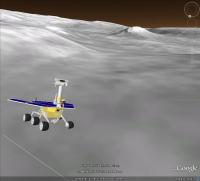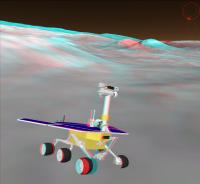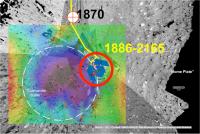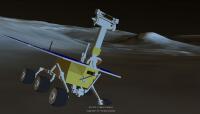Printable Version of Topic
Click here to view this topic in its original format
Unmanned Spaceflight.com _ Tech, General and Imagery _ Rover Orientation Data
Posted by: CosmicRocker May 28 2011, 04:20 AM
I am trying to quantify Spirit's final resting orientation, but I would generally like to learn how to determine the orientation of either rover for any particular sol. I'm sure this data is in the MMB files somewhere, but I haven't been able to identify it. Likewise, I am sure it is somewhere in the Analyst's Notebook database and/or the Pancam data tracking database, but again, I can't find it.
Spirit's final orientation is the main thing I am looking for, but any orientation assistance would be greatly appreciated.
Thanks.
Posted by: djellison May 28 2011, 04:27 AM
The PDS label label for just about every image, I think, includes a lot of orientation data. It's huge - but here's a segment of it
ROVER_MOTION_COUNTER = (138, 1230, 11, 148, 221)
ROVER_MOTION_COUNTER_NAME = (SITE, DRIVE, IDD, PMA, HGA)
.....
/* COORDINATE SYSTEM STATE: ROVER */
GROUP = ROVER_COORDINATE_SYSTEM
COORDINATE_SYSTEM_INDEX = (138, 1230, 11, 148, 221)
COORDINATE_SYSTEM_INDEX_NAME = (SITE, DRIVE, IDD, PMA, HGA)
COORDINATE_SYSTEM_NAME = ROVER_FRAME
ORIGIN_OFFSET_VECTOR = (-0.227241, 0.177903, 0.0358358)
ORIGIN_ROTATION_QUATERNION = (0.885949, -0.169903, 0.00321267,
-0.431529)
POSITIVE_AZIMUTH_DIRECTION = CLOCKWISE
POSITIVE_ELEVATION_DIRECTION = UP
QUATERNION_MEASUREMENT_METHOD = COARSE
REFERENCE_COORD_SYSTEM_INDEX = 138
REFERENCE_COORD_SYSTEM_NAME = SITE_FRAME
END_GROUP = ROVER_COORDINATE_SYSTEM
/* COORDINATE SYSTEM STATE: INSTRUMENT DEPLOYMENT DEVICE */
GROUP = IDD_COORDINATE_SYSTEM
COORDINATE_SYSTEM_INDEX = (138, 1230, 11, 148, 221)
COORDINATE_SYSTEM_INDEX_NAME = (SITE, DRIVE, IDD, PMA, HGA)
COORDINATE_SYSTEM_NAME = MI_FRAME
ORIGIN_OFFSET_VECTOR = (0.998908, -0.112816, -0.124504)
ORIGIN_ROTATION_QUATERNION = (0.559273, -0.497552, -0.443273, 0.493117)
POSITIVE_AZIMUTH_DIRECTION = CLOCKWISE
POSITIVE_ELEVATION_DIRECTION = DOWN
REFERENCE_COORD_SYSTEM_INDEX = (138, 1230, 11, 148, 221)
REFERENCE_COORD_SYSTEM_NAME = ROVER_FRAME
END_GROUP = IDD_COORDINATE_SYSTEM
/* ARTICULATION DEVICE STATE: PANCAM MAST ASSEMBLY */
GROUP = PMA_ARTICULATION_STATE
ARTICULATION_DEVICE_ID = "PMA"
ARTICULATION_DEVICE_NAME = "PANCAM MAST ASSEMBLY"
ARTICULATION_DEVICE_ANGLE = (0.553583 <rad>, 0.69753 <rad>,
0.553568 <rad>, 0.69766 <rad>,
1.21798 <rad>, -0.296728 <rad>)
ARTICULATION_DEVICE_ANGLE_NAME = ("AZIMUTH-MEASURED", "ELEVATION-MEASURED",
"AZIMUTH-REQUESTED",
"ELEVATION-REQUESTED", "AZIMUTH-INITIAL",
"ELEVATION-INITIAL")
ARTICULATION_DEVICE_MODE = DEPLOYED
END_GROUP = PMA_ARTICULATION_STATE
/* ARTICULATION DEVICE STATE: HIGH GAIN ANTENNA */
GROUP = HGA_ARTICULATION_STATE
ARTICULATION_DEVICE_ID = "HGA"
ARTICULATION_DEVICE_NAME = "HIGH GAIN ANTENNA"
ARTICULATION_DEVICE_ANGLE = (2.88001 <rad>, 0.0198442 <rad>)
ARTICULATION_DEVICE_ANGLE_NAME = (AZIMUTH, ELEVATION)
END_GROUP = HGA_ARTICULATION_STATE
/* ARTICULATION DEVICE STATE: FILTER */
GROUP = FILTER_ARTICULATION_STATE
ARTICULATION_DEVICE_ID = "FILTER"
ARTICULATION_DEVICE_NAME = "FILTER ACTUATORS"
ARTICULATION_DEV_POSITION = (8, 8, 1)
ARTICULATION_DEV_POSITION_ID = ("PANCAM_L8_440NM_SOL_ND5",
"PANCAM_R8_880NM_SOL_ND5", "MI_CLOSED")
ARTICULATION_DEV_POSITION_NAME = ("LEFT PANCAM FILTER", "RIGHT PANCAM
FILTER", "MI DUST COVER")
END_GROUP = FILTER_ARTICULATION_STATE
/* ARTICULATION DEVICE STATE: INSTRUMENT DEPLOYMENT DEVICE */
GROUP = IDD_ARTICULATION_STATE
ARTICULATION_DEVICE_ID = "IDD"
ARTICULATION_DEVICE_NAME = "INSTRUMENT DEPLOYMENT DEVICE"
ARTICULATION_DEVICE_ANGLE = (-0.118184 <rad>, -0.899982 <rad>,
1.53029 <rad>, 2.38935 <rad>,
1.5708 <rad>, -0.126481 <rad>,
-0.903681 <rad>, 1.53503 <rad>,
2.38834 <rad>, 1.516 <rad>)
ARTICULATION_DEVICE_ANGLE_NAME = ("JOINT 1 AZIMUTH-ENCODER", "JOINT 2
ELEVATION-ENCODER", "JOINT 3
ELBOW-ENCODER", "JOINT 4 WRIST-ENCODER",
"JOINT 5 TURRET-ENCODER", "JOINT 1
AZIMUTH-POTENTIOMETER", "JOINT 2
ELEVATION-POTENTIOMETER", "JOINT 3
ELBOW-POTENTIOMETER", "JOINT 4
WRIST-POTENTIOMETER", "JOINT 5
TURRET-POTENTIOMETER")
ARTICULATION_DEVICE_MODE = "FREE SPACE"
ARTICULATION_DEVICE_TEMP = (-23.8068 <degC>, -14.6212 <degC>)
ARTICULATION_DEVICE_TEMP_NAME = ("AZIMUTH JOINT 1", "TURRET JOINT 5")
ARTICULATION_DEV_VECTOR = (0.140944, -0.303824, 0.942245)
ARTICULATION_DEV_INSTRUMENT_ID = "MI"
ARTICULATION_DEV_VECTOR_NAME = GRAVITY
CONTACT_SENSOR_STATE = ("NO CONTACT", "NO CONTACT", CONTACT,
CONTACT, "NO CONTACT", "NO CONTACT", OPEN,
"NO CONTACT")
CONTACT_SENSOR_STATE_NAME = ("MI SWITCH 1", "MI SWITCH 2", "RAT SWITCH
1", "RAT SWITCH 2", "MB SWITCH 1", "MB
SWITCH 2", "APXS DOOR SWITCH", "APXS
CONTACT SWITCH")
END_GROUP = IDD_ARTICULATION_STATE
/* COORDINATE SYSTEM STATE: PANCAM MAST ASSEMBLY */
GROUP = PMA_COORDINATE_SYSTEM
COORDINATE_SYSTEM_INDEX = (138, 1230, 11, 148, 221)
COORDINATE_SYSTEM_INDEX_NAME = (SITE, DRIVE, IDD, PMA, HGA)
COORDINATE_SYSTEM_NAME = MAST_FRAME
ORIGIN_OFFSET_VECTOR = (0.45781, 0.02779, -1.09668)
ORIGIN_ROTATION_QUATERNION = (0.894388, -0.100912, 0.35272, 0.255881)
POSITIVE_AZIMUTH_DIRECTION = CLOCKWISE
POSITIVE_ELEVATION_DIRECTION = UP
REFERENCE_COORD_SYSTEM_INDEX = (138, 1230, 11, 148, 221)
REFERENCE_COORD_SYSTEM_NAME = ROVER_FRAME
END_GROUP = PMA_COORDINATE_SYSTEM
/* ARTICULATION DEVICE STATE: MOBILITY CHASSIS */
GROUP = CHASSIS_ARTICULATION_STATE
ARTICULATION_DEVICE_ID = "CHASSIS"
ARTICULATION_DEVICE_NAME = "MOBILITY CHASSIS"
ARTICULATION_DEVICE_ANGLE = (-0.0120352 <rad>, 0.00844853 <rad>,
-0.0256182 <rad>, -0.0516135 <rad>,
-0.382922 <rad>, -0.459977 <rad>,
0.158197 <rad>)
ARTICULATION_DEVICE_ANGLE_NAME = ("LEFT FRONT WHEEL POTENTIOMETER", "RIGHT
FRONT WHEEL POTENTIOMETER", "LEFT REAR
WHEEL POTENTIOMETER", "RIGHT REAR WHEEL
POTENTIOMETER", "LEFT BOGIE
POTENTIOMETER", "RIGHT BOGIE
POTENTIOMETER", "DIFFERENTIAL BOGIE
POTENTIOMETER")
ARTICULATION_DEVICE_MODE = DEPLOYED
END_GROUP = CHASSIS_ARTICULATION_STATE
....
/* DERIVED GEOMETRY DATA ELEMENTS: ROVER FRAME */
GROUP = ROVER_DERIVED_GEOMETRY_PARMS
INSTRUMENT_AZIMUTH = 31.9313 <deg>
INSTRUMENT_ELEVATION = 43.0455 <deg>
REFERENCE_COORD_SYSTEM_INDEX = (138, 1230, 11, 148, 221)
REFERENCE_COORD_SYSTEM_NAME = ROVER_FRAME
END_GROUP = ROVER_DERIVED_GEOMETRY_PARMS
/* DERIVED GEOMETRY DATA ELEMENTS: SITE FRAME */
GROUP = SITE_DERIVED_GEOMETRY_PARMS
INSTRUMENT_AZIMUTH = -38.2947 <deg>
INSTRUMENT_ELEVATION = 42.3127 <deg>
REFERENCE_COORD_SYSTEM_INDEX = 138
REFERENCE_COORD_SYSTEM_NAME = SITE_FRAME
SOLAR_AZIMUTH = 326.775 <deg>
SOLAR_ELEVATION = 45.0107 <deg>
END_GROUP = SITE_DERIVED_GEOMETRY_PARMS
That basically includes the complete 'state' of the vehicle. IDD, PMA, Wheels, Chassis, suspension...everything.
Posted by: CosmicRocker May 28 2011, 04:59 PM
Thanks, Doug. I wasn't aware of the label data. If I am understanding this data correctly, it appears that I will need to learn the mathematics of quaternions in order to make any sense of it. I wonder if there is any other source of data where the quaternions have been converted into something more intelligible to me.
Posted by: CosmicRocker May 29 2011, 06:28 AM
I'm just following up on my own question. I found a http://www.euclideanspace.com/maths/geometry/rotations/conversions/quaternionToEuler/index.htm that supposedly could convert a quaternion into a set of angles in degrees. Using the rover quaternion from Doug's example above, it returned the following results.
attitude -49.970826789740684 degrees
bank -27.62979515200747 degrees
Heading, attitude, and bank are apparently the equivalent of the aeronautical terms: yaw, pitch, and roll. A heading of about -12.7 degrees is slightly west of north, which seems reasonable. The attitude and bank angles are way too large to be reasonable for Spirit's orientation. I guess I have more work to do.
Posted by: nprev May 29 2011, 07:35 AM
Tom, I don't know if I'd discard the attitude & bank data just yet. For one thing, what is the reference for those numbers: local vertical or the martian geoid? Given that the source is probably the IMU, I'd bet on the latter. Also, recall that Spirit was already sideways (R side high) on the slope of Home Plate.
IMO, I don't find those numbers necessarily unreasonable. She was in a precarious situation.
Posted by: CosmicRocker May 30 2011, 05:43 AM
Thanks for the support, Nick. I haven't given up on them yet, but I am still confused. The converted angles don't seem to jive with the rover model displayed by MMB for the same location. I appreciate what you are saying, and you are probably right in questioning the reference. I'm trying to check that out. It also occurred to me that the reference could be a previous position.
I have no real experience with IMUs. There wouldn't be much difference between local vertical and a normal to the geoid, would there?
Posted by: AndyG May 30 2011, 10:35 AM
My maths - a dodgy A-level gained three decades ago - was required to use quaternions about a year ago on a 3d modelling issue in Flash. I "got it" after some struggling, wrote the code and it all worked well. A week later, the code still made some sense to me. When I came back to change some things a fortnight after that, I found it had become utterly unintelligible.
Quaternions, I think, mark my limit! Tough to gain, very easy to lose.
Andy
Posted by: nprev May 30 2011, 01:06 PM
Tom, my experience with inertial nav systems is almost entirely aircraft-related, so within that context the difference between local vertical & the geoid is significant enough to be considered, esp. during initial system alignment on Earth. (Choice of the reference geoid is also important; there are several in current use.) I don't know how refined such data is for Mars yet.
As you pointed out, though that might not matter for the MER INS. All that stuff matters for initial platform alignment on a planetary surface, which works basically like this for aircraft inertial systems:
1. Platform levels out orthogonal to local vertical.
2. Amount & direction of correction required to keep platform level over time (normally, a few minutes) is measured.
3. Correction rate is matched to expected drift rate to find latitude; correction direction used to find north. (Finding exact longitude is usually done by entering an appoximate longitude during the alignment process, which is subsequently refined by the system; there's no real easy way for the system to sense that independently.)
I suspect that the MERs haven't been going through full daily alignments for all this time; after morning wake-up, they might well just spin up to the last stored coordinates. Over time, this will drift (normally at a fixed rate) due to inherent & unavoidable minor mechanical imperfections in the system. Therefore, I wonder if this raw data you're working with might have substantial cumulative errors included that are subtracted during groundside processing @ JPL.
Anyhow. Sorry for the long stream-of-consciousness post; was trying to think this through. ![]() Good luck!
Good luck!
Posted by: jamescanvin May 30 2011, 01:13 PM
Tom, I played around with rover quaternions years ago, I was never totally convinced I had got it working exactly right but comparing my code with the maths on calculator you posted I think you need to swap the last two elements over. Then you get numbers close to what I get from code I've used in the past to automatically generate panoramas with flat horizons.
heading -50.58337307972186 degrees
attitude 8.761900410435159 degrees
bank -17.565753444479686 degrees
I'm not sure what the -50 for heading refers to as Spirt was facing very close to north, I have only every been interested in the pitch (attitude) and roll (bank) numbers which are about right I think.
Posted by: nprev May 30 2011, 04:38 PM
James, all I can think is that the heading figure may be expressed in relative terms; maybe -50 deg off of the rover's longitudinal axis at platform alignment? Again, it's extremely important to understand the reference axes & error correction set to interpret this data.
Posted by: djellison May 30 2011, 04:41 PM
I could believe a heading of 310 deg. They do fine calibration of the IMU on a regular basis - (normally cited as a 'QFE' I believe) - and I'm sure one would have occurred very close to the final location.
Posted by: Tesheiner May 30 2011, 05:26 PM
IIRC the rover's attitude is recalculated whenever a new "site" is declared. The "sun-finding" sequences are used for that purpose.
Posted by: nprev May 30 2011, 05:40 PM
Eduardo, do you mean for heading? I don't think that solar location would help very much for attitude. However, the Sun's position is an excellent reference for both heading & longitude computation.
EDIT: Apologies; upon further reflection, yes, you could indeed derive attitude data via solar observation, although it seems that considerable interpolation of not only the Sun's angle with the horizon but also its orientation within the frame would be required. But the IMU itself would almost certainly have to be the primary data source, so the question again becomes what sorts of references & error corrections are involved for IMU data interpretation.
Posted by: CosmicRocker May 30 2011, 07:45 PM
This is turning into quite an interesting topic. I didn't expect to find so many people contributing. That's what I love about this forum. Thanks to all for your contributions. ![]()
James: I think you may be on to something. Flipping the last two elements in that calculator seems to result in much more reasonable numbers...and, numbers that are agreeing qualitatively with the orientation of the rover model in MMB for the few locations I have tested. I want to do a little more testing, but this could be a breakthrough. ![]()
Posted by: CosmicRocker May 31 2011, 05:05 AM
Aside from simply wanting to know what Spirit's final orientation is, I started working on this project because I wanted to be able to insert a rover model into the virtual 3D space of Google Mars. Ultimately, I wanted to be able to generate Google Mars anaglyphs similar to http://www.unmannedspaceflight.com/index.php?s=&showtopic=6438&view=findpost&p=160034 almost a year ago. Because Google has a high resolution DEM of Spirit's Inner Valley location, I thought it would be interesting to try some close up views of the terrain with a model of Spirit in context. Ultimately, I would like to create an image in tribute to Spirit's historic mission. But, I need to work the bugs out of the process, first. ![]()
To give you an idea of what I am talking about, here are a couple of preliminary images. The model in these images is using the orientation angles that James posted above, so you can see how they look next to Home Plate.
First, here is a screenshot of a scene from Google Mars.
This is synthesized anaglyph view of Spirit's final location.
Posted by: CosmicRocker Jun 2 2011, 05:53 AM
Thanks for that tip. I am currently trying to identify the latest fine calibration of the IMU, in order to determine when the last, most accurate, attitude was known. Apparently, it is actually called a QFA (get Quick Fine Attitude). The latest one I am sure of was on sol 2148. There might have been one done on sol 2163, but I am not sure. I am still a newbie with regard to digging through the Analyst's Notebook.
I grabbed a new quaternion from sol 2149 to see what Spirit's orientation looked like on the sol after the QFA. The results are below. Although the tilts are almost the same as those James posted earlier for the last known location(~50 sols later), the heading is about 25 degrees closer to north. I wonder, is there another Fine Attitude adjustment that is not "Quick" that I should be looking for?
heading -23.937463611379624 degrees
attitude 7.372538578449687 degrees
bank -17.376799086843732 degrees
Posted by: AndyG Jun 2 2011, 11:02 AM
Looking at these angles makes me wonder what the real pointing accuracy of a MER is. Or "was", for Spirit. ![]()
I mean, a figure down in the 10-15 of a degree range equates to an angle of around six inches at one light year. Almost-sort-of handy when doing the maths on multiple quaternion rotations (and then rounding down) but essentially meaningless in any real sense.
Andy
Posted by: CosmicRocker Jun 2 2011, 05:43 PM
Of course, most of those digits are meaningless. I simply copied the output directly from the online calculator. For my purposes, I'll be happy with angles that are accurate to within a few degrees.
Posted by: Deimos Jun 2 2011, 08:18 PM
A few thoughts on the IMU/QFA issue ...
- The IMU is used whenever there is mobility. It tracks changes in attitude, by which I mean the vector or quaternion describing the rover's orientation (not just one element of said vector). The QFA or GFA (get fine attitude, which takes longer and is not quick) is run when the inertial measurement needs updating. The Sun measurements are critical to this.
- The Sun imaging in the QFA/GFA is not just a single image. It is a set. Position of the Sun in one image gives you two pieces of information (direction of the Sun, for instance in rover frame azimuth and elevation). Imaging over time gives you two more (d_az/d_t, d_el_dt). They are not fully orthognal, but are enough to populate roll,pitch,yaw or a quaternion (the quaternion is 4 numbers, but they quadratically add to 1, so only 3 degrees of freedom). A long IMU integration ensures that the attitude is over-determined. The orientation of the Sun in the frame is not determinable, except from infeerence based on motion.
- The frames of reference are the rover body frame and local level (i.e., areoid). I doubt the difference between "orthoganal to gravity" and "orthoganal to the radius vector" add up to much at either MER site.
- Time is actually part of the error budget, and affects the derivation from Solar images but not IMU. You couldn't refine longitude with solar imaging, since time knowledge can drift by up to 30 sec between corrections, and there are PMA-related uncertainties on top of that.
- The attitude is updated every time the IMU is used. A QFA/GFA updates the site. A drive does not end with the same attitude as it starts with. Those changes are tracked with the IMU, reported in the images, and used to point the HGA at Earth. This happens many times per QFA.
- The last quaternion I see, sol 2209, is [0.885949, -0.169903, 0.0031267, -0.431529] (Doug's). For that I get a tilt of 19.6 deg WSW, yaw=309 (51 W of N) pitch=-8.1 (nose down), roll=17.7 (+Y/right-hand panel up). So that's pretty close to what James got, no surprise there.
Posted by: CosmicRocker Jun 3 2011, 05:10 PM
Mark: Thanks for taking the time to post those informative comments. You answered many of the questions that have come up in this discussion. I am especially pleased to get your verification on the orientation angles.
Now that we know that we are converting the quaternion data correctly, the only question remaining in my mind is how accurate is the final orientation. I did a little more digging around in the Analyst's Notebook and discovered that a "Get Quick Fine Attitude" was performed on sol 2164 and that there were only two subsequent drive attempts (one on sol 2165 and the last on sol 2169). These drives were attempts to improve the rover's northerly tilt for the coming winter. The mission Manager's reports indicate little improvement was achieved.
I am going to conclude that the final orientation is accurate, since there were only two attempts to move the rover after the final QFA.
I also found this nifty little map attached to the documentation from those sols showing Spirit pointing to the heading we expected. ![]()
Posted by: nprev Jun 4 2011, 12:07 AM
Yes, thank you, Deimos, for taking the time for that informative reply! I've always been interested in how the MER INS works at this level of detail; again, I'm used to aircraft & therefore high speeds-over-ground with alignment referenced to a geophysical frame.
Posted by: CosmicRocker Jun 4 2011, 09:05 PM
Now that we have Spirit's final orientation defined I can post the model for others to use in Google Mars. The model has been saved in the correct orientation, so all you'll need to do is drag it to Eduardo's final location in Google Mars. As long as you don't grab the "rotation" handle while you are adjusting it's position, it should appear in exactly the correct orientation.
I got this model originally as a http://sketchup.google.com/3dwarehouse/details?mid=9f1021ec701fd96dc82b8fee1057b30. However, the original model was not correctly scaled. I scaled it to the correct size in Sketchup, oriented it to the angles provided by Deimos, adjusted it's vertical position so that the left side wheels would appear partially buried, and then finally exported it as a Collada model that can be easily imported into Google Earth/Mars.
I suspect there may be a general interest in the model, but I thought I would post it here first to see if it worked properly for people and didn't have any bugs I haven't spotted. If no one identifies any problems, I'll post it in the main Spirit thread. Final_Spirit_scaled_oriented3v7.zip ( 296.46K )
: 539
Final_Spirit_scaled_oriented3v7.zip ( 296.46K )
: 539
Once you have the model, it is easy to create your own custom views of Spirit in her surroundings.
Powered by Invision Power Board (http://www.invisionboard.com)
© Invision Power Services (http://www.invisionpower.com)




